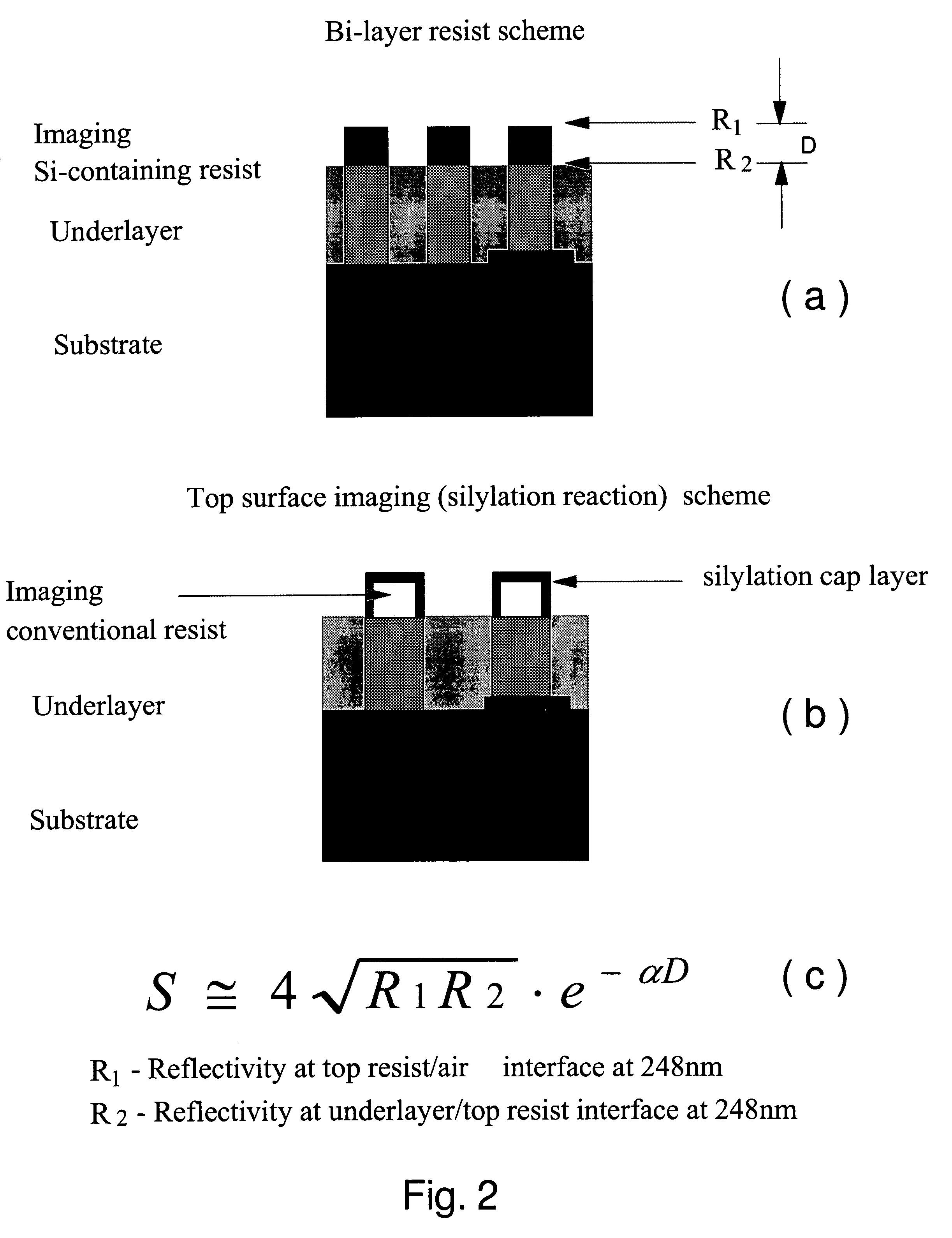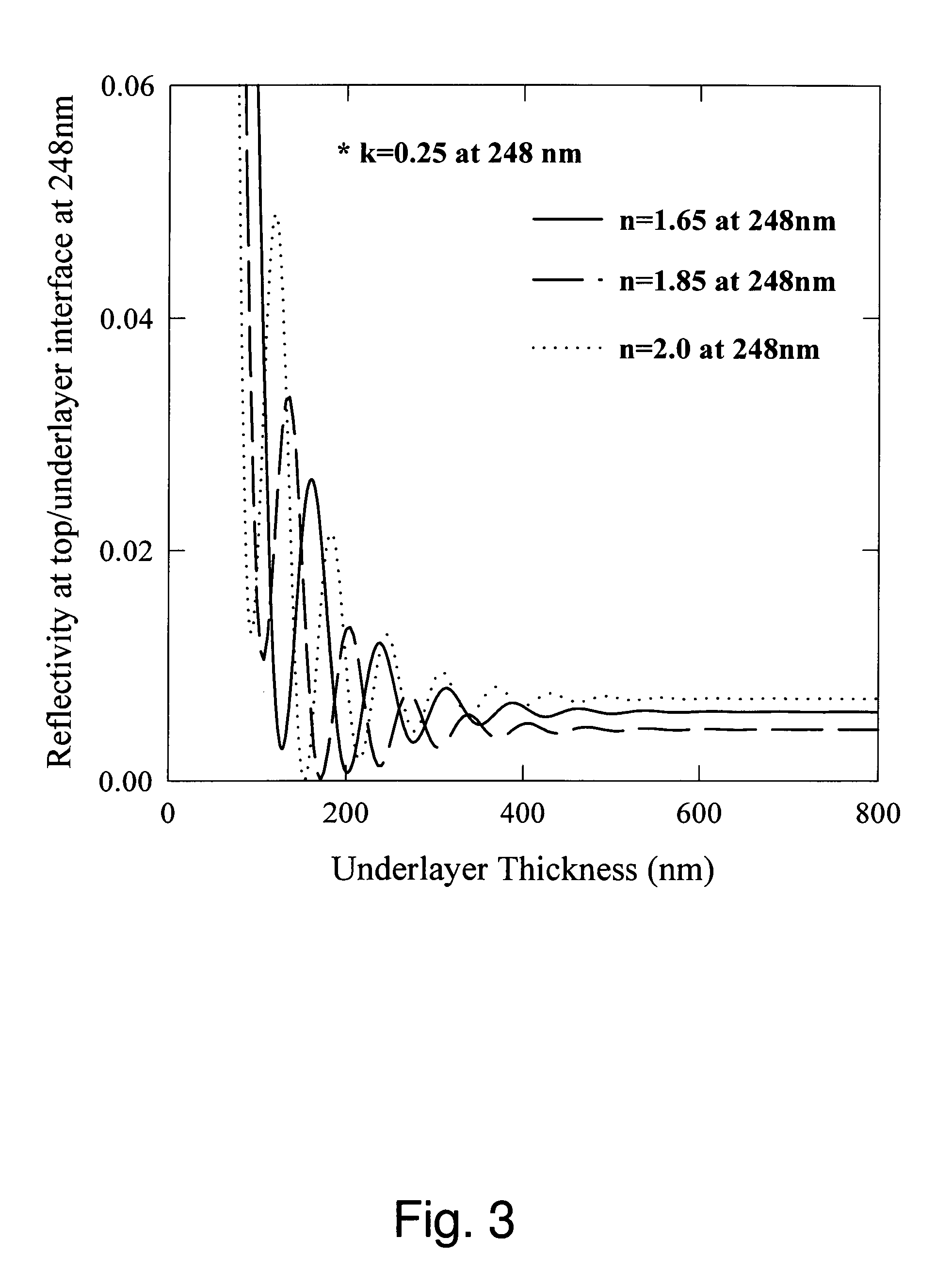Multilayered resist systems using tuned polymer films as underlayers and methods of fabrication thereof
- Summary
- Abstract
- Description
- Claims
- Application Information
AI Technical Summary
Benefits of technology
Problems solved by technology
Method used
Image
Examples
example 1
[0082]The following example illustrates calculations for obtaining optimum bottom layer parameters of a bilayer system. Parameters are optimized so as to reduce reflections at the resist / underlayer interface. Computations are based on algorithms which use the Fresnel coefficients as found in standard textbooks such as Optics, by E. Hecht and A. Zajac, published in 1979 by Wiley, pages 312 and 313. These simulations can be extended to many different structures and they are not limited by the examples given below. The structure simulated in this example includes a Si substrate, underlayer and photoresist. The parameters under investigation are the bottom layer optical constants n and k and film thickness d. The imaging Si-containing resist index of refraction extinction coefficient k and film thickness are fixed and given by n=1.78, k=0.018 and d=2000 A at 248 nm. FIG. 3 shows reflectivity at the underlayer / resist interface at 248 nm as a function of underlayer thickness for different...
example 2
[0084]The following example illustrates how to measure the optical constants n and k of the underlayer materials. This measurement technique can be applied to a variety of different processes and it is not limited by the two example above.
[0085]The optical constants were measured using an n&k Analyzer manufactured by n&k Technology, S. Clara, Calif. A description of this instrument and its operation can be found in U.S. Pat. No. 4,905,170, 1990. They use a method based on broadband spectrophotometry and equations for optical constants derived by Forouhi and Bloomer (Phys. Rev. B, 38, pp. 1865-1874, 1988). Their analysis is based on a physical model for the refractive index, n, and extinction coefficient, k, applicable to a wide range of semiconductor and dielectric films, and valid over the deep ultraviolet—near infrared wavelength range. The n(λ) and k(λ) (λ is the wavelength) spectra of any material cannot be measured directly but they are determined from a de-convolution of a ref...
example 3
[0088]The following example is given to demonstrate the tuning of optical properties of novolac / diazonapthoquinone underlayers. The optical properties of the coated novolac / diazonapthoquinone materials that described in this example are: 1) the index of refraction (n) at 248 nm, 2) the extinction coefficient (k) at 248 nm and 3) the absorption coefficient (α) 248 nm was calculated from equation (1) above. Shipley grade 2 novolak had been spun coated onto 8″ wafers then soft baked at 120C for 30 seconds and hard baked at four different temperatures: 225, 250, 252, 275 and 300 degrees C. for 90 seconds using contact hotplates. Optical properties of novolac films measured by method described in example 2 and summarized in Table 1. We have found a strong correlation between the optical properties of novolak underlayers and processing conditions. Novolac underlayers found hard to control due to high dependance of n and k values on process temperature.
PUM
 Login to View More
Login to View More Abstract
Description
Claims
Application Information
 Login to View More
Login to View More - R&D
- Intellectual Property
- Life Sciences
- Materials
- Tech Scout
- Unparalleled Data Quality
- Higher Quality Content
- 60% Fewer Hallucinations
Browse by: Latest US Patents, China's latest patents, Technical Efficacy Thesaurus, Application Domain, Technology Topic, Popular Technical Reports.
© 2025 PatSnap. All rights reserved.Legal|Privacy policy|Modern Slavery Act Transparency Statement|Sitemap|About US| Contact US: help@patsnap.com



